Explore 9 Common Types of Blenders in Pharma
Blending involves the thorough mixing of different ingredients. Then the mixture could be prepared for further processing, such as capsule filling and tablet compression. Therefore, it is critical in pharmaceutical manufacturing. Its primary goals are to ensure consistent distribution of active pharmaceutical ingredients and excipients. In this way, it ensures the effectiveness and safety of the medication.
If you want excellent blending process, a high-quality blender is a must. There are various types of blenders to choose from. Every type is suitable for different techniques and materials. This article helps you get a thorough understanding of common mixer types. Then you can select the most suitable one based on your production needs.
9 Common Types of Mixers
Ribbon Blenders
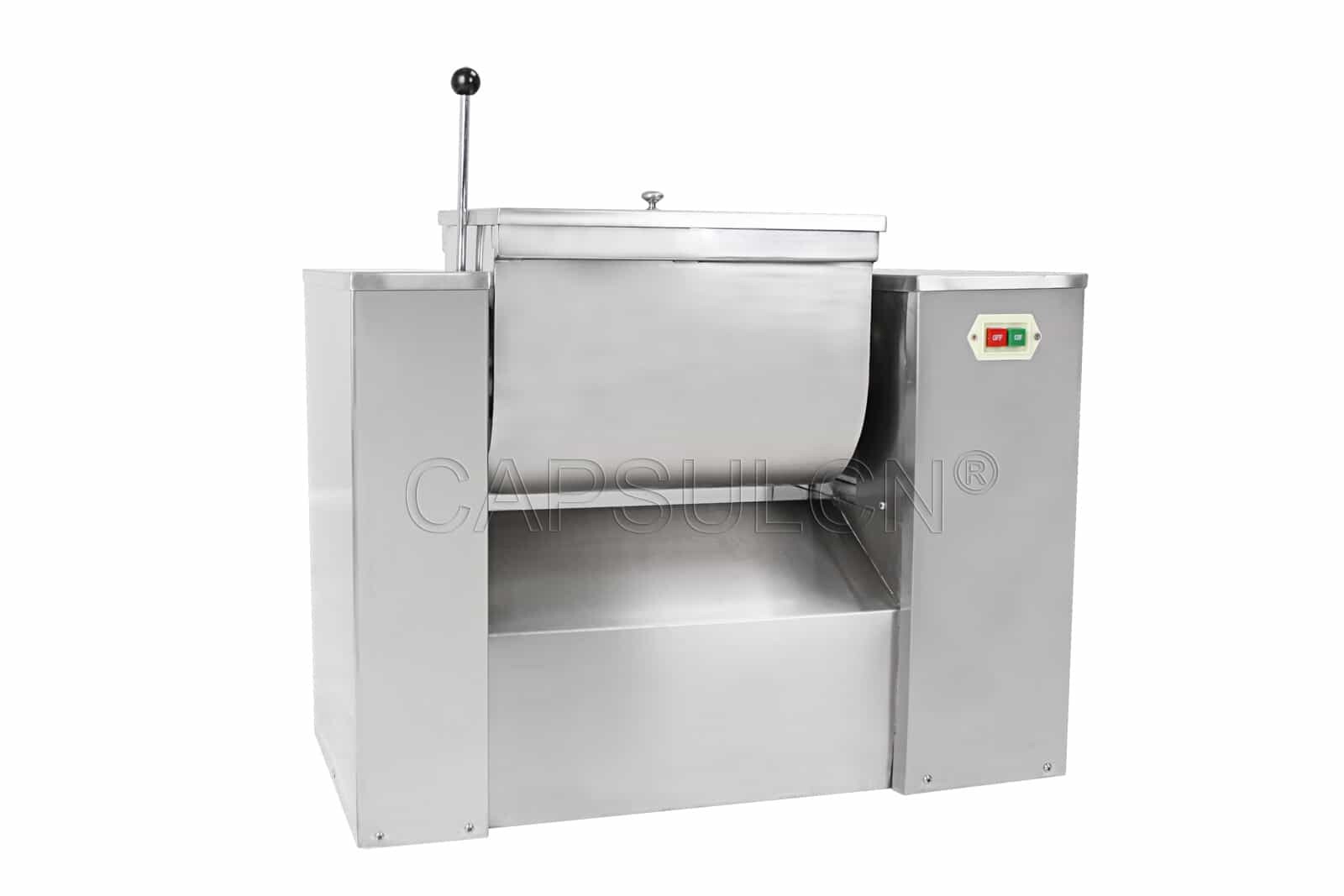
Ribbon blenders consist of a motor, a speed reducer and a horizontal U-shaped trough. On the trough, there is a central shaft fitted with helical ribbons, both inner and outer. When running, the speed reducer drives the central shaft. The shaft then rotates the ribbons. These ribbons rotate in opposite directions to create a counter-current flow. It ensures thorough and uniform mixing of materials. Additionally, this type of blender is especially suitable for small batch testing, but not ideal for large batches of semi-solid or sticky materials.
Ribbon blenders are mainly used in the pharmaceutical industry. They are applied to mix dry or wet materials, including powders and granules. They do not affect the material properties during mixing. It means they do not dissolve, volatilize, or degrade the materials. Besides the pharmaceutical industry, ribbon blenders are also used in the chemical and food industries.
If you wonder how a ribbon blender works, here is a video for your reference.
Double Cone Mixer
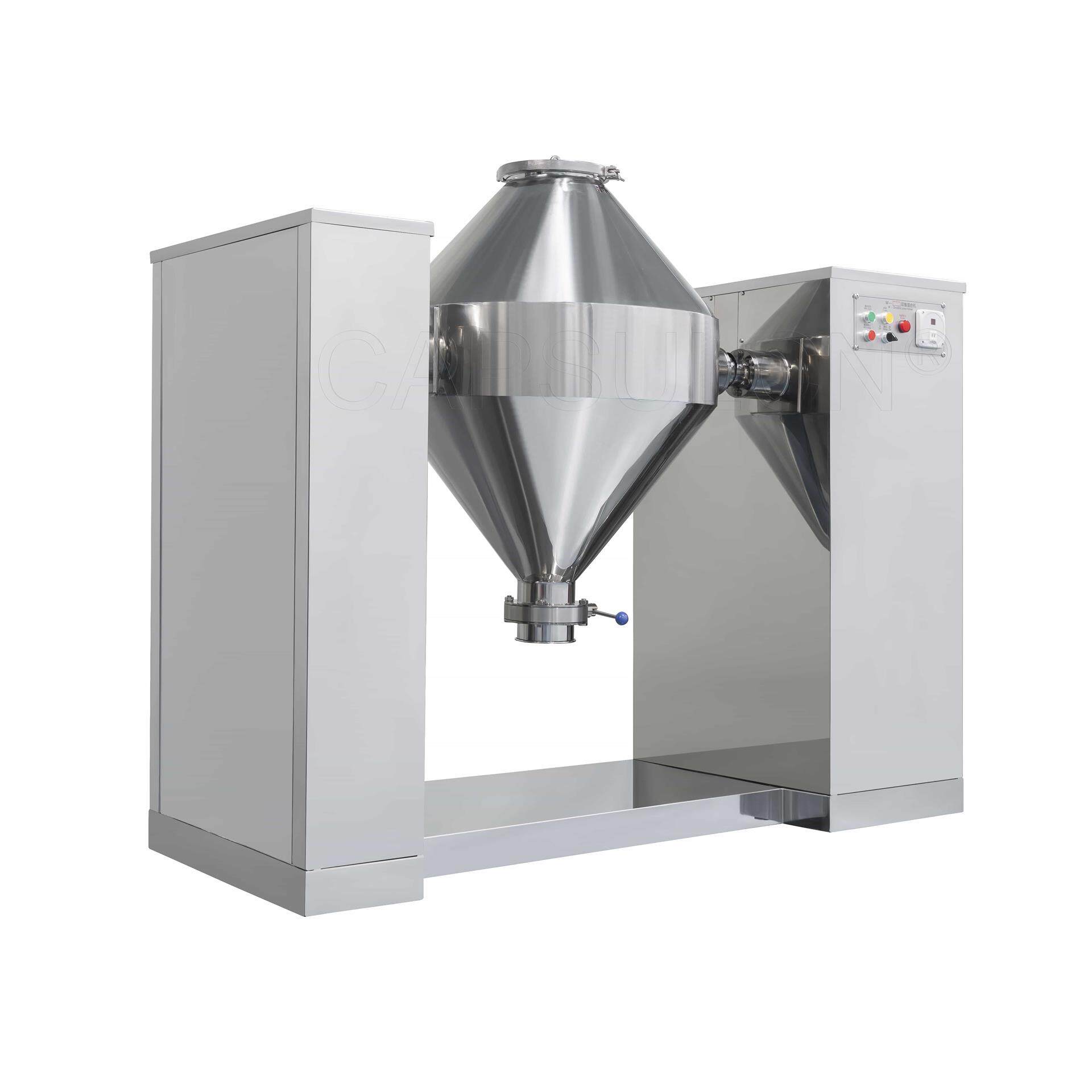
Double cone mixers are popular types of blending machines. They look like two ice cream cones stuck together at their open ends. They achieve uniform mixing through fast rotation and flipping. During this process, materials inside the container move in all directions, ensuring thorough blending. This machine is known for its effective mixing and high uniformity of blends.
This type of mixer handles particles gently, making it suitable for delicate mixing tasks. It generates very low heat, which helps protect sensitive materials from damage. Besides pharmaceuticals, it is commonly used in the food industry for blending spices and additives. It is also used in cosmetics for preparing powder mixtures.
Here is a video to show you how it works.
V Cone Blender
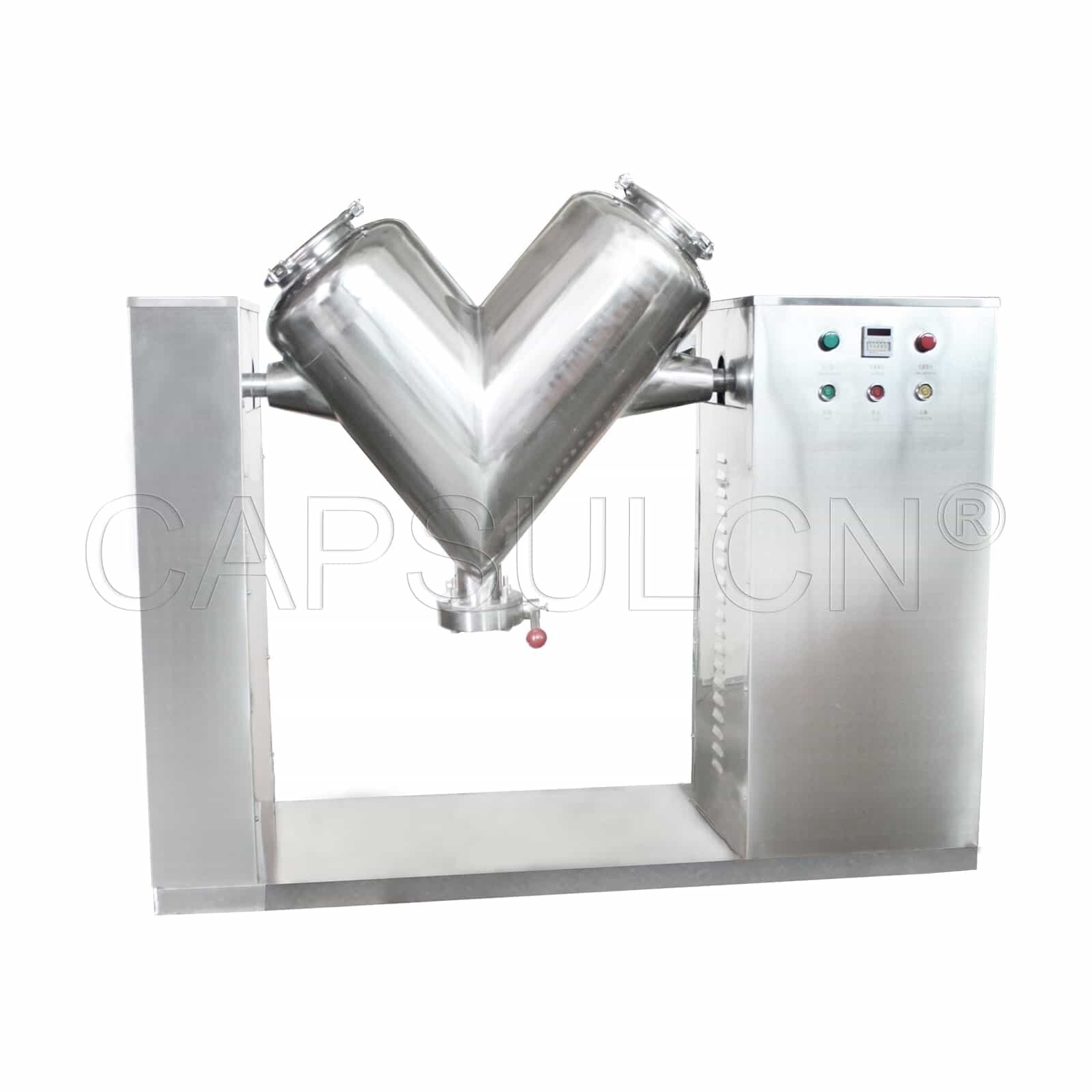
A V cone blender, also known as a twin shell blender, is widely used in industries like pharmaceuticals and chemicals. It consists of two interconnected cylinders. They form together a V shape. It can cause efficient blending by creating fluidized zones within the vessel. When the blender rotates on a horizontal axis, the materials are tumbled and mixed thoroughly. V cone blenders are ideal for blending dry powders and granules. But they are not suitable for very soft materials due to low shear force.
This machine has 2 openings for loading materials. They are located on the top of the V-shaped vessel. And the opening on the bottom is used for discharging the mixture. They all feature a dust-right design to prevent contamination. V cone blenders can handle various mixing tasks with minimal maintenance. And they are easy for use and maintenance.
If you are interested in this machine, check the video to see how it works.
3D Mixers
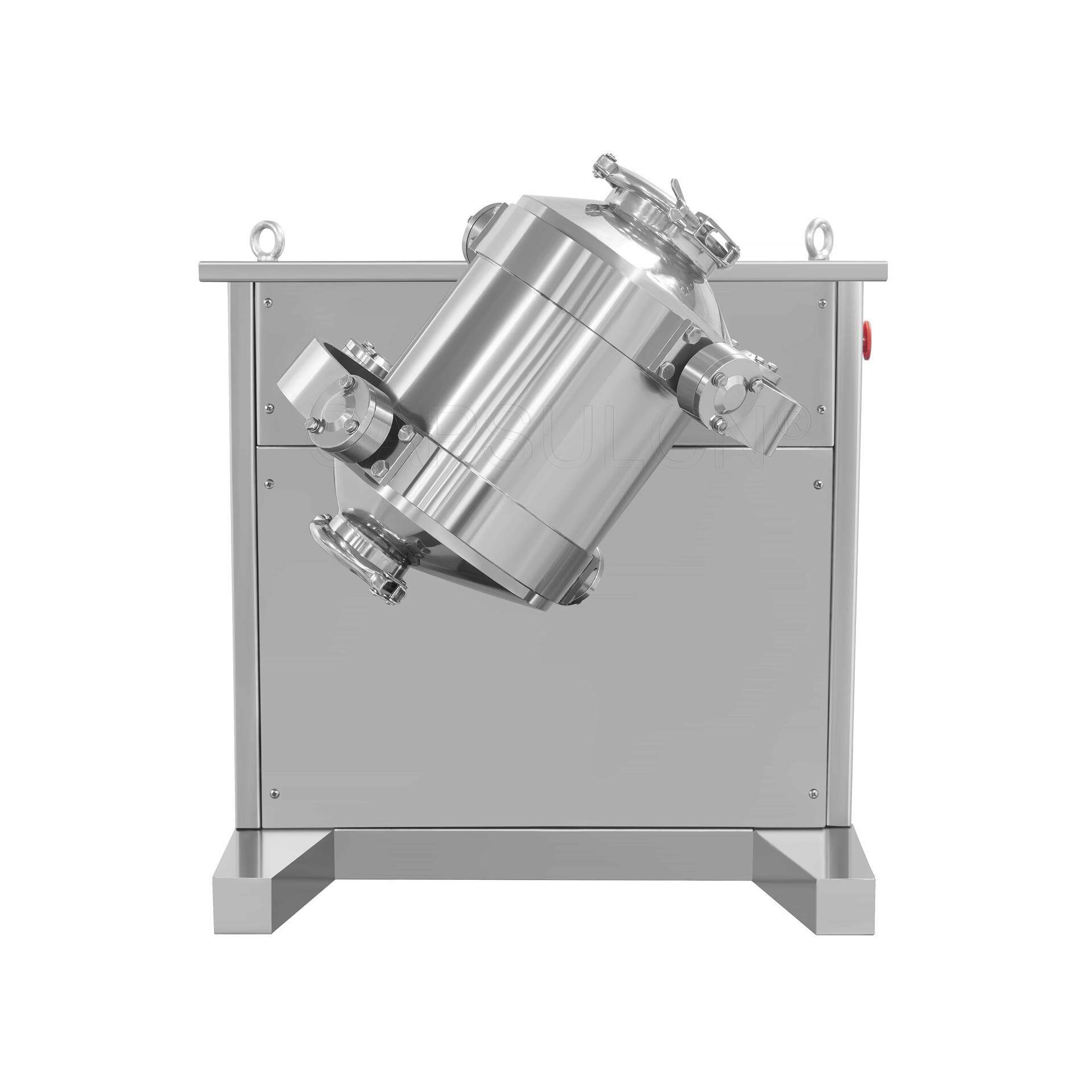
3D mixers feature high efficiency with short blending time. In this machine, the mixing vat moves in multiple directions, creating many cross-mixing points.This leads to a mixing uniformity of over 99.9%. Its loading efficiency is up to 0.9. it is much higher than 0.4-0.6 of normal blenders. Moreover, the multi directional movement results in better mixing homogeneity and lower error rates than general mixers.
This blender are suitable for mixing powder or granules with good flowing properties. It is common used in pharmacy, chemical industry, and food industry. You can check the video to see how a 3D blender works.
Octagonal Blenders
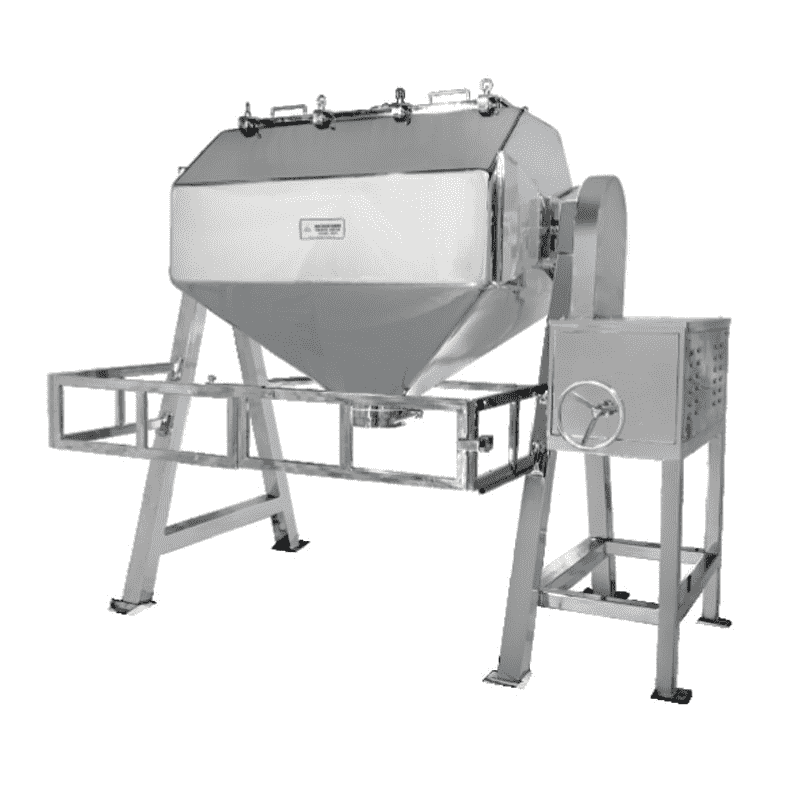
An octagonal blender is mainly used to mix dry solids and semi-solid materials. It has an eight-sided shape which helps in thorough blending. The working principle is similar to that of double cone blenders. The blender works by rotating the octagonal container. The material is then tumbled evenly from different directions. Compared to other mixers, octagonal blenders require a less rotating speed.
An octagonal blender features the octagonal mixing drum, a motor, and other essential parts such as a discharge valve. This blender is suitable for materials that need gentle mixing. Because the mixing doesn’t cause too much stress on the particles. It reduces the risk of breaking the particles.
High Shear Mixers

This type of blender mixes ingredients thoroughly at high speeds. It is designed to break down large particles into smaller ones for blending. This machine can help achieve a more uniform and stable mixture. Take pharmaceutical manufacturing for example. When mixing active drug ingredients with excipients, it sometimes needs to refine particles to enhance drug solubility and bioavailability.
A high shear mixer works with a rotor-stator system. The rotor is a fast-spinning part that creates strong forces. And the stator is a stationary part with holes. When the rotor spins, it pulls in the materials, pushing them through the stator's holes. This action breaks down particles and mixes them evenly.
These mixers are suitable for liquids, semi-solids like creams, and powders to form suspensions. They offer adjustable speeds to control the mixing intensity. This type mixer also comes in various sizes, from small lab models to large industrial ones.
Homogenizers

Homogenizers are machines that mix liquids into a stable and uniform mixture. The liquids are mainly emulsions and suspensions. They can break down large particles formed by insolubility or settling. These particles will be reduced down into tiny pieces and distributed evenly. They use high pressure or ultrasonic waves to complete it.
Homogenizers improve stability and ensure consistent quality. Sometimes, they are used with high shear mixers to create even finer blends. Homogenizers are used in many industries. In food, they make milk smooth and sauces uniform. In pharmaceuticals, they help mix creams and drugs evenly. In cosmetics, they blend oils and water in lotions.
Paddle Blenders
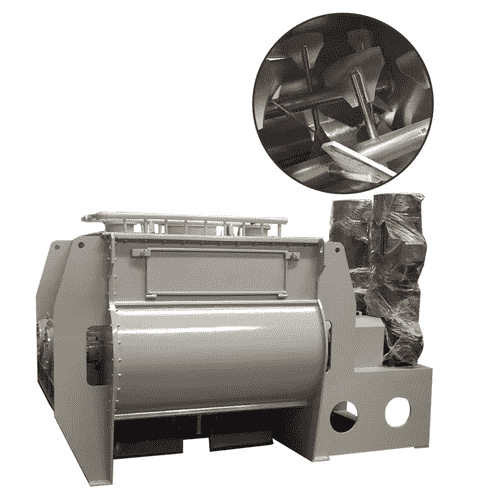
This type of blender belongs to horizontal blenders. It is designed with flat and wide paddles. These paddles are mounted on a horizontal shaft. When mixing starts, the paddles rotate around the horizontal shaft. It uses gravity to continuously tumble the raw materials, ensuring thorough blending. This method is gentle on materials. So it is suitable for mixing fragile powders or granules.
Paddle blenders are also capable of handling wet and dry mixing. They can also be used for blending powders with liquids. So its applications are more diverse than other types of blenders. If your materials require precise thermal management. You can customize jackets for heating or cooling. It allowes for temperature control during the mixing process.
Conical Screw Mixers

This blender is used for mixing powders, granules, and some types of pastes or slurries. It consists of a conical vessel and a rotating screw. When blending, the screw lifts the materials from the bottom to the top and allows them to fall back down. This process repeats, providing efficient and thorough mixing. Meanwhile, this machine allows three-dimensional mixing. It ensures that materials are blended in all directions for more even mix.
A conical screw mix has a wide range of benefits. Besides efficient mixing, it supports gentle handling because of low shear force. So it is deal for delicate materials that could be damaged by aggressive mixing methods.
How to Choose a Good Mixer Grinder?
Quality
In the pharmaceutical industry, quality is a key factor. A good mixer must ensure consistent and uniform blending for effective further processing. You should look for machines that comply with GMP. If necessary, ask your supplier to provide related certifications like the FDA.
High-quality mixers often have robust construction, precision engineering, and reliable motors. They should also feature safety mechanisms like overload protection. It prevents machine damage and ensure a long-time use.
Material Properties
You may know different materials are suitable for different blenders. Various materials have varying densities, particle sizes, and flow characteristics. They can affect mixing efficiency and evenness. A suitable mixer should accommodate these properties. While ensuring thorough blending, it shouldn’t cause any material damage.
Costs
It's important to find a mixer that fits your budget while meeting your need. If your budget is tight, focus on essential features such as adequate motor power, durable materials, and safety certifications. If you have a higher budget, consider to invest in high-end models. They often come with robust construction and higher efficiency. It leads to better performance and lower maintenance costs over time.
The End
Different blender types meet various mixing needs in pharma industry. Each type has its own benefits based on the materials and blending purposes. So you should chose the most suitable one for your medicine making business. If you wonder how to select one, feel free to contact us.
Leave your comment
Also Offers


Containment Automatic Capsule Filling Machine SFK-703

Fully Automatic Dosator Capsule Filling Machine CZ-40

Our Team
As an expert in the pharmaceutical and pharmaceutical packaging industry, iPharMachine has provided solutions for hundreds of pharmaceutical and health product manufacturers for 17 years. By visiting customers, we get good reviews from our customers.
- info@ipharmachine.com
- English Español Deutsche







